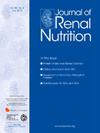作为肌肉质量替代指标的 ESRD 前 24 小时尿肌酐随时间的变化以及 ESRD 后的死亡率。
IF 3.4
3区 医学
Q2 NUTRITION & DIETETICS
引用次数: 0
摘要
目的:肌肉质量下降和肌肉疏松症是慢性肾脏病和 ESRD 患者的常见病,在慢性肾脏病进展期,肌肉疏松症会隐性恶化。目前尚不清楚肾功能逐渐丧失患者肌肉疏松症的时间动态及其与未来预后的关系:方法:我们从美国退伍老兵的当代全国队列中挑选了 661 名患者,这些患者在转为 ESRD 之前的三年前奏期间至少进行了两次 24 小时尿肌酐(24hrUC)测量,这是肌肉质量的替代指标。我们在混合效应模型中估计了 24hrUC 的斜率。为了评估 ESRD 前 24hrUC 的时间动态变化及其与不断变化的 eGFR 的关系,我们在混合效应模型中分别拟合了 24hrUC 与时间和 eGFR 的惩罚性样条回归。我们使用经混杂因素调整的 Cox 模型研究了 24hrUC 斜率与透析后全因死亡率的关系:24hrUC与时间的平均斜率为-78毫克/年(95%CI:-102至-54),ESRD前最后一年的下降幅度更大。24hrUC下降越严重,全因死亡率越高:24hrUC每下降100毫克/年,经多变量调整后的死亡危险比为1.41(95%CI:1.00-1.98,P=0.05):结论:晚期慢性肾功能衰竭患者在ESRD前期每年都会损失很大一部分肌肉。结论:晚期慢性肾功能衰竭患者在ESRD前奏期间每年都会损失大量肌肉,在ESRD转归期附近,肌肉质量的损失会加速,肌肉质量损失越多,ESRD转归期后的死亡率越高。本文章由计算机程序翻译,如有差异,请以英文原文为准。
Change Over Time in Pre–End-Stage Renal Disease 24-Hour Urine Creatinine as Muscle Mass Surrogate and Post–End-Stage Renal Disease Mortality
Objective
Loss of muscle mass and sarcopenia are common in chronic kidney disease (CKD) and end-stage renal disease (ESRD), and sarcopenia can worsen insidiously in patients with advancing CKD. The temporal dynamics of sarcopenia in patients with progressive loss of kidney function, and its association with future outcomes, is unclear.
Methods
In a contemporary national cohort of incident ESRD US veterans, we selected 661 patients who had at least 2 24-hour urine creatinine (24hrUC) measurements, a surrogate of muscle mass, performed during the 3-year prelude period prior to ESRD transition. We estimated 24hrUC slopes in mixed effects models. To assess the temporal dynamics of pre-ESRD changes in 24hrUC and its association with changing eGFR, we separately fitted in mixed effects models a penalized spline regression of 24hrUC on time and on eGFR. We examined the association of 24hrUC slopes with postdialysis all-cause mortality using Cox models adjusted for confounders.
Results
The mean slope of 24hrUC versus time was −78 mg/year (95% confidence interval: −102 to −54), with a steeper decline noted in the last year prior to ESRD. More severe decreases in 24hrUC were associated with higher all-cause mortality: a 100 mg/year decrease in 24hrUC was associated with a multivariable adjusted death hazard ratio of 1.41 (95% confidence interval: 1.00-1.98, P = .05).
Conclusion
Patients with advanced CKD lose a substantial proportion of their muscle mass each year during pre-ESRD prelude. Loss of muscle mass accelerates near ESRD transition, and more loss of muscle mass is associated with higher mortality after ESRD transition.
求助全文
通过发布文献求助,成功后即可免费获取论文全文。
去求助
来源期刊

Journal of Renal Nutrition
医学-泌尿学与肾脏学
CiteScore
5.70
自引率
12.50%
发文量
146
审稿时长
6.7 weeks
期刊介绍:
The Journal of Renal Nutrition is devoted exclusively to renal nutrition science and renal dietetics. Its content is appropriate for nutritionists, physicians and researchers working in nephrology. Each issue contains a state-of-the-art review, original research, articles on the clinical management and education of patients, a current literature review, and nutritional analysis of food products that have clinical relevance.
 求助内容:
求助内容: 应助结果提醒方式:
应助结果提醒方式:


